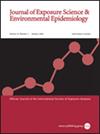长期接触高度污染的饮用水后全氟烷基物质(PFAS)的经胎盘转移效率:一项在罗尼比母婴队列中的研究。
IF 4.7
3区 医学
Q2 ENVIRONMENTAL SCIENCES
Journal of Exposure Science and Environmental Epidemiology
Pub Date : 2025-03-06
DOI:10.1038/s41370-025-00758-2
引用次数: 0
摘要
背景:全氟烷基物质(PFAS)是一种稳定的化学品,用于各种用途。PFAS暴露与儿童低出生体重和免疫影响有关,有限的证据进一步表明不良的神经发育影响。先前的研究表明,PFAS在怀孕期间穿过胎盘屏障,导致胎儿产前暴露。对PFAS在高暴露人群中的移植转移效率(TTE)研究不足。目的:本研究旨在估计8种PFAS和3种全氟辛烷磺酸(PFOS)异构体在广泛PFAS暴露的出生队列中的TTE,并调查母体暴露水平是否影响估计的TTE。方法:在暴露结束后的2015年至2020年期间招募参与者,其中大多数人曾暴露于pfas污染的城市饮用水。我们收集了孕妇妊娠和分娩时的血清样本,以及脐带血清。血清样品采用液相色谱-串联质谱(LC-MS/MS)分析。TTE以脐带血清PFAS浓度与母体血清PFAS浓度之比估算。我们使用了考虑母体特征的广义加性混合模型来评估母体暴露水平(即高、中等或背景)是否改变了估计的TTE。结果:本研究共纳入200对脐带及母体血清样本。暴露剖面以全氟己烷磺酸(PFHxS)和全氟辛烷磺酸为主。我们观察到PFHxS的总转移效率最高(平均TTE: 0.68),而n-PFOS异构体的总转移效率最低(平均TTE: 0.33)。背景暴露双体中PFHxS和PFOS(总和同分异构体)的te值较高。影响声明:在一个主要暴露于受污染饮用水的全氟辛烷磺酸和全氟辛烷磺酸的出生队列中,我们发现8种全氟辛烷磺酸和3种全氟辛烷磺酸异构体的胎盘转移效率(TTE)相当大。PFOA和PFHxS以及支链PFOS同分异构体的TTE均高于线性。虽然我们观察到,与背景水平暴露的母子二代相比,高暴露和中等暴露的母子二代的TTE略低,但高暴露母亲的相当大的TTE意味着受污染地区儿童的绝对产前暴露量高。本文章由计算机程序翻译,如有差异,请以英文原文为准。

Transplacental transfer efficiency of perfluoroalkyl substances (PFAS) after long-term exposure to highly contaminated drinking water: a study in the Ronneby Mother-Child Cohort
Perfluoroalkyl substances (PFAS) are stable chemicals used in various applications. PFAS exposure has been associated with lower birth weight and immunological effects in children, and limited evidence further suggests adverse neurodevelopmental effects. Previous studies show that PFAS cross the placental barrier during pregnancy leading to prenatal exposure of the fetus. Research on the transplacental transfer efficiency (TTE) of PFAS in highly exposed populations is lacking. This study aimed to estimate the TTE of eight PFAS and three perfluorooctane sulfonic acid (PFOS) isomers in a birth cohort with a wide range of PFAS exposures and to investigate if maternal exposure level impacted the estimated TTE. The participants, most of whom had been exposed to PFAS-contaminated municipal drinking water, were recruited between 2015 and 2020 after the end of exposure. We collected maternal serum samples during pregnancy and at delivery, as well as umbilical cord serum. Serum samples were analyzed using liquid chromatography-tandem mass spectrometry (LC-MS/MS). TTE was estimated as the ratio of the PFAS concentration in cord serum to maternal serum. We used generalized additive mixed models accounting for maternal characteristics to assess if maternal exposure level (i.e., high, intermediate, or background) modified the estimated TTE. The study included 200 dyads with matched cord and maternal serum samples. The exposure profile was dominated by perfluorohexane sulfonic acid (PFHxS) and PFOS. We observed the highest overall transfer efficiency for PFHxS (median TTE: 0.68) and the lowest for the n-PFOS isomer (median TTE: 0.33). Higher TTEs were observed for PFHxS and PFOS (total and isomers) in background-exposed dyads. In a birth cohort with a wide range of exposures to primarily PFOS and PFHxS from contaminated drinking water, we found that the transplacental transfer efficiencies (TTE) of eight PFAS and three PFOS isomers were of considerable magnitude. The highest TTE were observed for PFOA and PFHxS, and for branched PFOS isomers compared with linear. Although we observed slightly lower TTE in mother-child dyads with high and intermediate exposures compared with dyads with background levels of exposure, the considerable TTE in highly exposed mothers implies high absolute prenatal exposure in children in contaminated areas.
求助全文
通过发布文献求助,成功后即可免费获取论文全文。
去求助
来源期刊
CiteScore
8.90
自引率
6.70%
发文量
93
审稿时长
3 months
期刊介绍:
Journal of Exposure Science and Environmental Epidemiology (JESEE) aims to be the premier and authoritative source of information on advances in exposure science for professionals in a wide range of environmental and public health disciplines.
JESEE publishes original peer-reviewed research presenting significant advances in exposure science and exposure analysis, including development and application of the latest technologies for measuring exposures, and innovative computational approaches for translating novel data streams to characterize and predict exposures. The types of papers published in the research section of JESEE are original research articles, translation studies, and correspondence. Reported results should further understanding of the relationship between environmental exposure and human health, describe evaluated novel exposure science tools, or demonstrate potential of exposure science to enable decisions and actions that promote and protect human health.

 求助内容:
求助内容: 应助结果提醒方式:
应助结果提醒方式:


